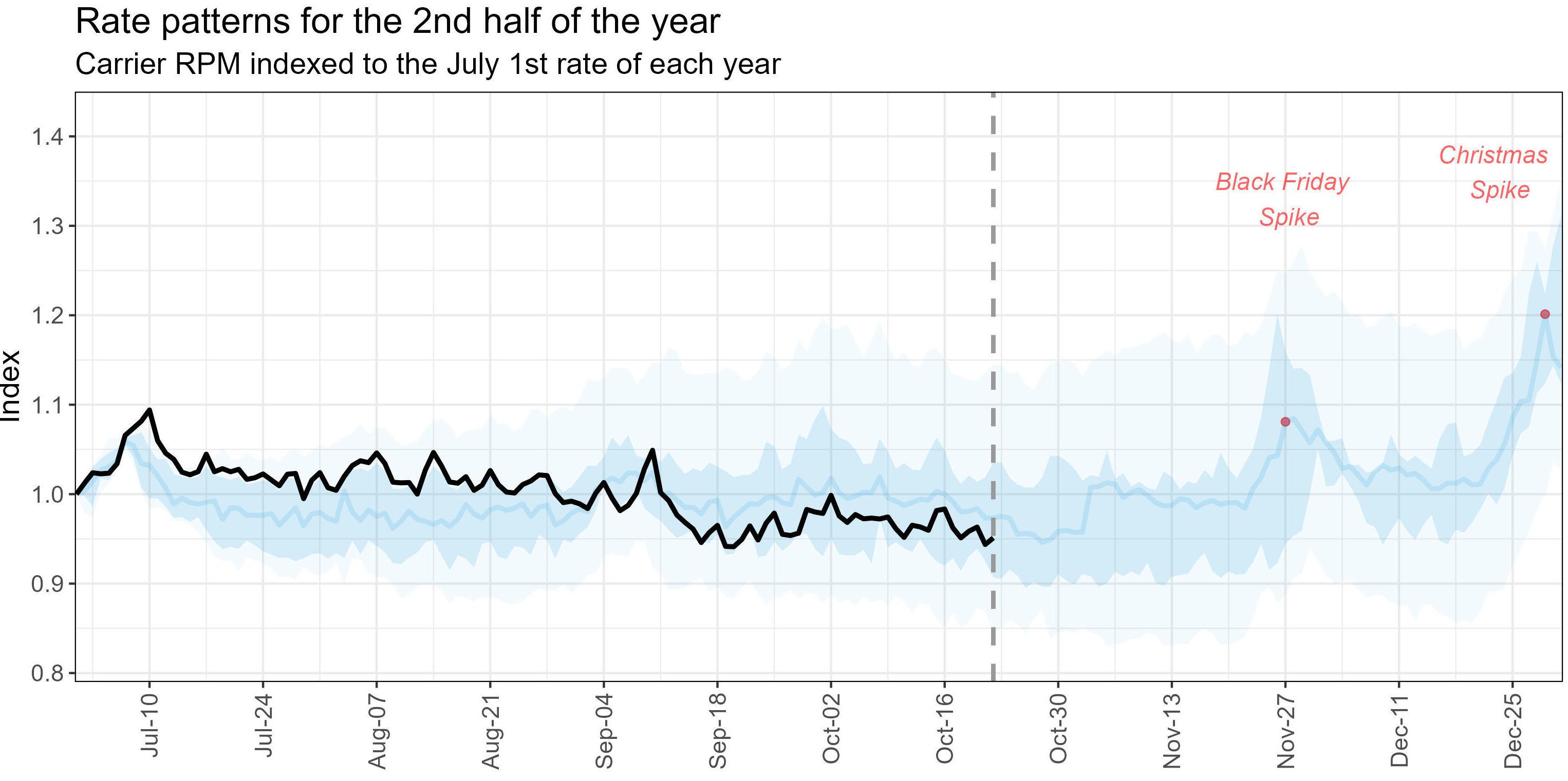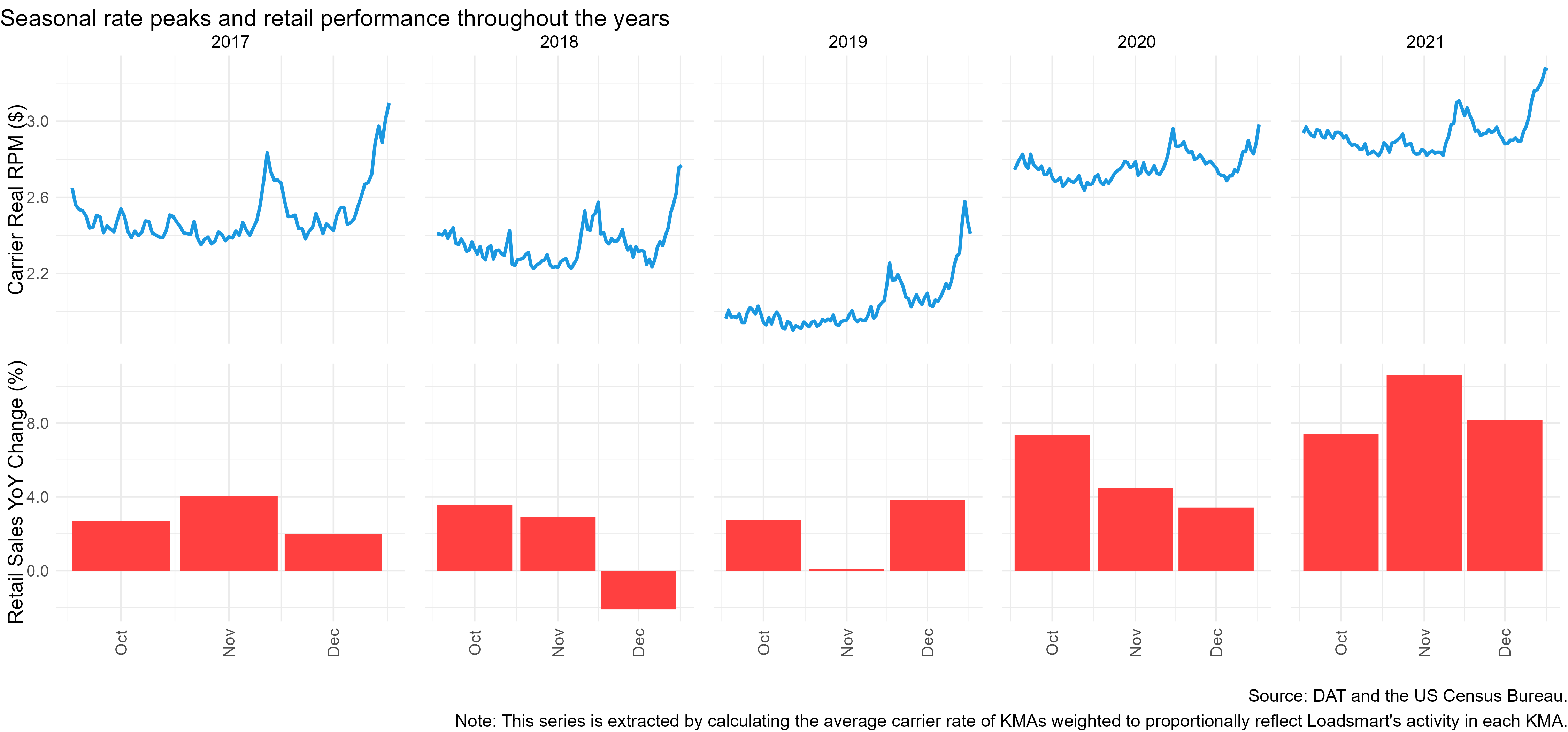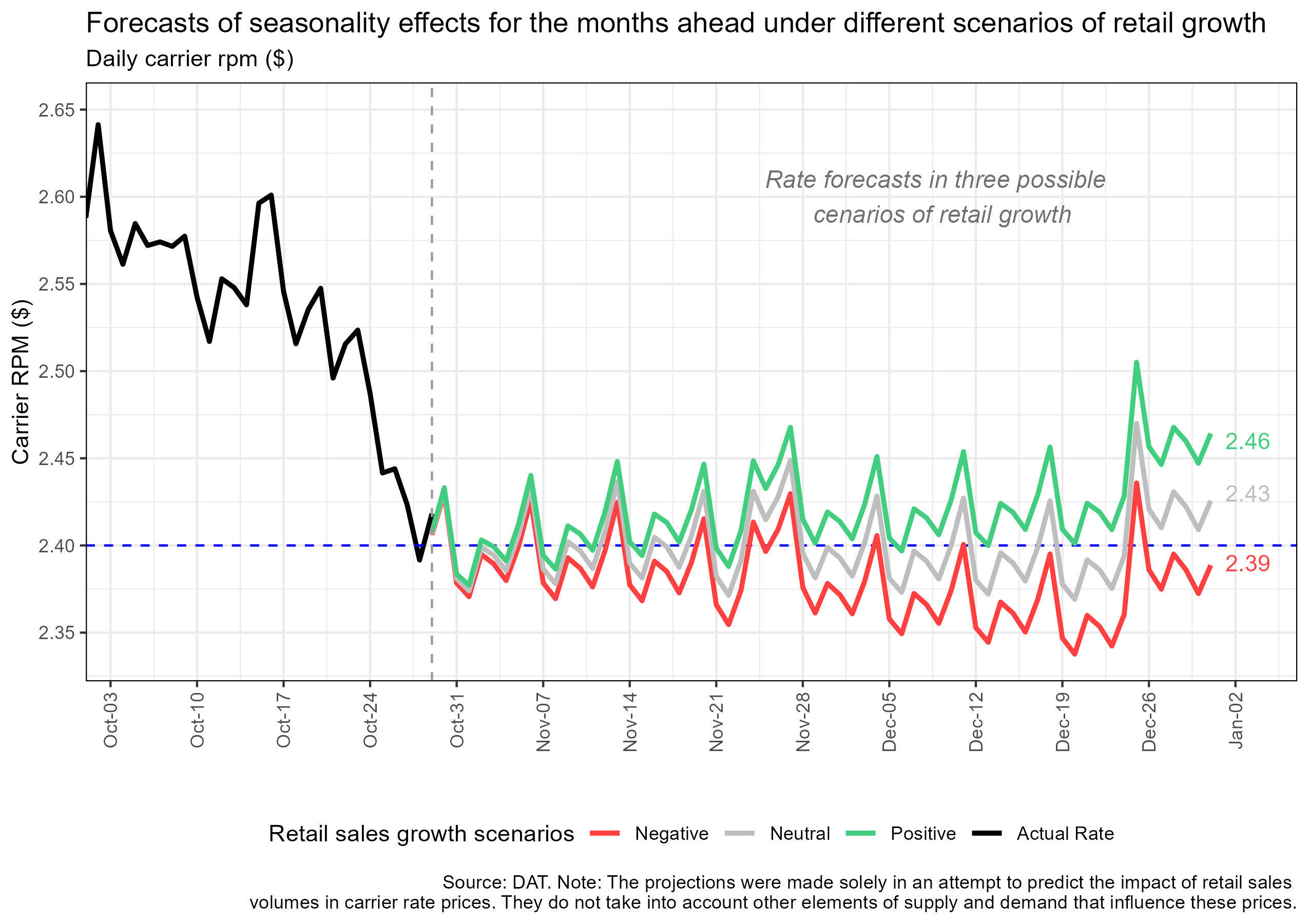Share this
Will the gloomy freight market experience any holiday tightening?
by jpallmerine
Will the gloomy freight market experience any holiday tightening? Potential Q4 price impacts from peak retail season.
As the holiday season approaches, retail sales performance comes under close watch as a core element capable of providing a lift to the increasingly gloomy freight market. Thanksgiving/Black Friday and Christmas shopping sprees have historically driven market shifts for carrier rates for the last five years. The consumer spending boosts & tightened capacity surrounding the two holidays have historically contributed to a median spike in carrier rates by 10% and 20%, respectively, when compared to Q3 prices – Figure 1.

Since 2017, rates have temporarily gained momentum during the fourth quarter even when retail sales growth was weak, as Figure 2 shows, due to tightened capacity. But after the pandemic, seasonal rate volatility began fading because, even amid the exceptional performance of retail in 2020 and 2021, freight price bumps were modest compared to past years. This is possibly due to (i) significant amounts of capacity entering to compete in the hot market and/or (ii) prices were already too high to begin with.

It’s hard to guess at a glance whether there will be any seasonal rate peaks during this year’s holiday season. Firstly because from 2017-2021, there was no generalized recessive scenario that shadowed the entire fourth quarter (as we may have today) and, apart from the COVID-19 outbreak period (Mar to May/20), retail sales dips were sporadic and detached from any lasting trend. Secondly, shippers are well aware of their market position in the driver’s seat which will enable them to mitigate typical seasonal cost increases (the excess capacity in the market easily absorbed the Hurricane Ian disruption, for example).
Under this unprecedented scenario, we attempt to forecast carrier rate’s evolution for the next months using more sophisticated techniques with the goal of understanding how Q4 retail sales performance (either positive or negative) will impact the freight market. The forecast is done considering three possible scenarios for retail sales in the next three months:
- Negative: decline 2.5% YoY;
- Neutral: remain stable – 0% YoY change;
- Positive: increase 2.5 % YoY.
We have arbitrarily chosen this interval for retail sales movement to help us understand the causal effect of it on rates. But given that the average retail sales YoY growth since March is -0.5%, we believe that next months’ rates will likely be within the simulated interval – Figure 3.

The rate predictions based on the retail sales scenarios are displayed in Figure 4. Based on our estimates, holiday seasonal effects would start kicking in only after Nov’ 22nd. The Black Friday bump should occur from Nov’ 23th to Dec’ 4th and the Christmas bump should begin on Dec’ 22nd.

In a negative or neutral scenario, the downtrend would last through November, ceasing during the Black Friday bump period but resuming shortly after. Rates would bottom on December 20th, in time for the Christmas peak. In a positive scenario, we would reach the yearly bottom by the beginning of November; and, after the first bump, the market would stabilize at $2.4 levels till the Christmas peak.
In closing, it’s important to emphasize that this article is solely focused on studying the impact that retail sales movements could have on truckload pricing in the Q4 peak season. The study is performed based on historical data analysis and therefore intentionally ignores additional factors that could influence freight supply and demand this year.
Please reach out to Stella Carneiro (stella.carneiro@loadsmart.com) or Jon Payne (jonathan.payne@loadsmart.com) with any questions, suggestions, thoughts, etc. Thank you!
Share this
- Loadsmart Blog (159)
- Blog (121)
- Shipper (106)
- Market Trends (100)
- Enterprise Shipper (69)
- Carrier (66)
- News (62)
- Data Insights (51)
- Thought Leadership (45)
- Warehouse (41)
- SMB Shipper (38)
- Our Partners (34)
- ShipperGuide TMS (31)
- Opendock (30)
- Product Updates (29)
- Mode Optimization (25)
- Loadsmart (23)
- Mid-Market Shipper (18)
- Case Study (17)
- Brokerage Services (15)
- Managed Transportation (11)
- Video (9)
- Award (7)
- FreightIntel AI (5)
- Instant Execution (4)
- Asset (3)
- Food and Beverage (3)
- Freight Management (3)
- Logistics Solutions (3)
- YMS (3)
- eBook (3)
- 4PL (2)
- International (2)
- NavTrac (2)
- Podcast (2)
- UK (2)
- Yard Management System (2)
- Cold Storage (1)
- Faces of Loadsmart (1)
- Paper Packaging (1)
- Retail (1)
- Security (1)
- Transportation Management System (1)
- December 2025 (1)
- November 2025 (1)
- October 2025 (2)
- September 2025 (1)
- August 2025 (1)
- July 2025 (1)
- June 2025 (1)
- May 2025 (7)
- April 2025 (6)
- March 2025 (3)
- February 2025 (10)
- January 2025 (4)
- December 2024 (4)
- November 2024 (5)
- October 2024 (11)
- September 2024 (11)
- August 2024 (5)
- July 2024 (5)
- June 2024 (9)
- May 2024 (7)
- April 2024 (6)
- March 2024 (2)
- February 2024 (2)
- January 2024 (5)
- December 2023 (6)
- November 2023 (2)
- October 2023 (12)
- September 2023 (5)
- August 2023 (3)
- July 2023 (4)
- June 2023 (10)
- May 2023 (5)
- April 2023 (5)
- March 2023 (7)
- February 2023 (5)
- January 2023 (7)
- December 2022 (4)
- November 2022 (13)
- October 2022 (4)
- September 2022 (7)
- August 2022 (11)
- July 2022 (6)
- June 2022 (5)
- May 2022 (2)
- April 2022 (4)
- March 2022 (6)
- February 2022 (7)
- January 2022 (9)
- December 2021 (3)
- November 2021 (5)
- October 2021 (7)
- September 2021 (2)
- August 2021 (2)
- July 2021 (4)
- June 2021 (6)
- May 2021 (6)
- April 2021 (5)
- March 2021 (8)
- February 2021 (3)
- January 2021 (3)
- December 2020 (7)
- November 2020 (9)
- October 2020 (7)
- September 2020 (6)
- August 2020 (10)
- July 2020 (8)
- June 2020 (3)
- May 2020 (1)
- April 2020 (2)
- March 2020 (2)
- February 2020 (1)
- January 2020 (1)
- November 2019 (2)
- October 2019 (1)
- September 2019 (2)
- August 2019 (3)
- July 2019 (2)
- June 2019 (2)
- May 2019 (3)
- March 2019 (1)
- February 2019 (3)
- December 2018 (1)
- November 2018 (2)
- October 2018 (1)
- September 2018 (2)
- August 2018 (1)
- July 2018 (1)
- June 2018 (3)
- May 2018 (4)
- April 2018 (1)
- February 2018 (1)
- January 2018 (4)
- November 2017 (1)
- October 2017 (2)
- June 2017 (1)
- May 2017 (2)
- April 2017 (1)
- February 2017 (1)
- January 2017 (2)
- October 2016 (1)
- August 2016 (1)
- July 2016 (2)
- June 2016 (1)
- March 2016 (1)
- January 2016 (1)
- December 2015 (3)
- November 2015 (2)
- October 2015 (6)
- July 2015 (1)
- June 2015 (1)
- April 2015 (2)
- March 2015 (13)
- February 2015 (17)
- January 2015 (15)
- December 2014 (35)
- November 2014 (26)
- October 2014 (60)
- September 2014 (2)